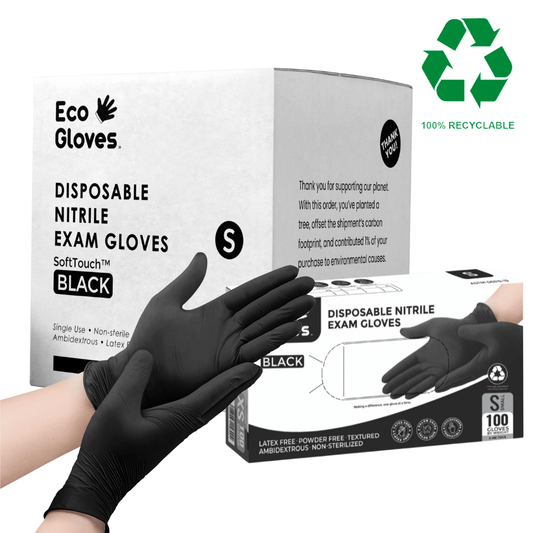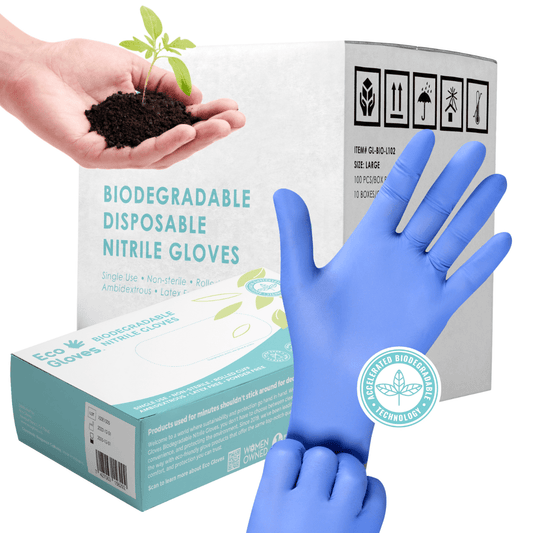Addressing Common Myths About Disposable Gloves: Facts vs. Fiction
Eco Gloves
Disposable gloves play a vital role in maintaining hygiene and protecting against contamination across various industries. From healthcare and food services to household use, these gloves have become a cornerstone of modern hygiene practices. However, misconceptions about disposable gloves abound, leading to confusion and improper usage.
This article aims to debunk some of the most common myths about disposable gloves with accurate, research-backed information. Let’s separate fact from fiction and highlight the real story behind these everyday tools.
Topics Covered
- Myth 1: All Disposable Gloves Are The Same
- Myth 2: Disposable Gloves Are 100% Effective Against Germs And Viruses
- Myth 3: Disposable Gloves Are Always Harmful To The Environment
- Myth 4: You Can Reuse Disposable Gloves
- Myth 5: Gloves Replace The Need For Handwashing
- Myth 6: Only Healthcare Workers Need Disposable Gloves
- Myth 7: Biodegradable Gloves Are Less Durable
- Myth 8: Disposable Gloves Are Costly And Unsustainable For Businesses
- Myth 9: All Glove Waste Ends Up In Landfills
- Choosing The Right Glove: Balancing Protection And Sustainability
- Key Takeaways: Myths vs. Facts About Disposable Gloves
- Frequently Asked Questions
Myth 1: All Disposable Gloves Are The Same
Fiction
Some people believe that all disposable gloves, regardless of their material, offer the same level of protection and functionality.
Fact
Disposable gloves are made from a variety of materials, each with unique properties suited for specific tasks. Common glove types include:
- Latex Gloves: Highly elastic and provide excellent dexterity. Best for non-allergic users in medical or cleaning environments.
- Nitrile Gloves: Resistant to punctures and chemicals, making them ideal for healthcare and industrial settings.
- Vinyl Gloves: Cost-effective and suitable for short-term use, particularly in food handling.
- Biodegradable Gloves: Eco-friendly options like plant-based and compostable gloves are increasingly popular for reducing environmental impact.
Different materials cater to different needs, and choosing the right glove depends on the intended purpose. For example, nitrile gloves are best for handling harsh chemicals, while plant-based options align with sustainability goals.
Myth 2: Disposable Gloves Are 100% Effective Against Germs And Viruses
Fiction
Wearing gloves guarantees complete protection against germs, bacteria, and viruses.
Fact
While disposable gloves significantly reduce the risk of contamination, they are not foolproof. Effectiveness depends on:
- Proper Usage: Gloves must fit snugly and be changed frequently.
- Hand Hygiene: Washing hands before and after wearing gloves is critical to minimize risks.
- Material Integrity: Using gloves appropriate for the task ensures durability and resistance to punctures.
The CDC (Centers for Disease Control and Prevention) emphasizes that gloves are an additional layer of protection—not a substitute for good hygiene practices. Improper glove use can actually spread contamination.

Myth 3: Disposable Gloves Are Always Harmful To The Environment
Fiction
All disposable gloves contribute equally to environmental waste and pollution.
Fact
While traditional gloves (made from materials like nitrile, latex, or vinyl) pose environmental challenges, innovative, sustainable solutions are now available. Many companies offer biodegradable and compostable options designed to minimize landfill waste.
Studies show that bio-based gloves can break down into natural elements in composting environments, reducing their environmental footprint. Choosing sustainable gloves is a responsible choice for both businesses and individuals aiming to prioritize eco-friendliness.Myth 4: You Can Reuse Disposable Gloves
Fiction
It’s safe and economical to sanitize and reuse disposable gloves.
Fact
Disposable gloves are designed for single use only. Reusing them compromises their integrity and increases the risk of contamination. Research published by the National Institute Of Health underscores that reusing gloves can spread pathogens due to micro-tears and reduced barrier effectiveness.
Instead of attempting to reuse disposable gloves, opt for durable, reusable gloves designed for long-term use if frequent glove use is required for certain tasks.

Myth 5: Gloves Replace The Need For Handwashing
Fiction
Wearing gloves eliminates the need to wash hands.
Fact
Gloves act as a physical barrier but do not replace the necessity of hand hygiene. Germs can transfer to the gloves during donning, and improper removal can cause cross-contamination. Proper handwashing or the use of hand sanitizer before and after glove use remains essential.
According to WHO (World Health Organization) guidelines, maintaining hand hygiene is a critical step in infection control, even when gloves are worn.
Myth 6: Only Healthcare Workers Need Disposable Gloves
Fiction
Disposable gloves are exclusive to medical and healthcare professionals.
Fact
While healthcare professionals rely heavily on disposable gloves, they are indispensable in many other industries, including:
- Food Service: Gloves ensure cleanliness while handling food.
- Household Cleaning: They protect against harsh chemicals and dirt.
- Beauty and Salon Services: Gloves maintain hygiene during treatments.
- Industrial Applications: Chemical-resistant gloves safeguard workers in manufacturing and laboratory environments.
Everyday use of gloves, especially in public spaces or during activities like grocery shopping or commuting, has also gained popularity, particularly post-pandemic.

Myth 7: Biodegradable Gloves Are Less Durable
Fiction
Eco-friendly gloves compromise on durability and performance.
Fact
Advances in material science have made biodegradable gloves as durable and effective as traditional gloves. High-quality biodegradable options combine superior performance with environmental benefits. They provide adequate strength, flexibility, and barrier protection for a wide range of applications.
Testing and certifications ensure that these gloves meet stringent standards for safety and usability.
Myth 8: Disposable Gloves Are Costly And Unsustainable For Businesses
Fiction
Sustainable disposable gloves are too expensive for widespread use in business operations.
Fact
While eco-friendly gloves might have slightly higher upfront costs, their long-term benefits outweigh the expenses. By adopting sustainable practices, businesses can enhance their reputation, meet environmental goals, and potentially qualify for green certifications.
Myth 9: All Glove Waste Ends Up In Landfills
Fiction
There’s no alternative to landfill disposal for used disposable gloves.
Fact
Many sustainable gloves are designed to decompose in industrial composting facilities. Additionally, recycling programs are emerging for specific types of gloves, reducing their environmental impact. Consumers and businesses can also take steps to ensure proper disposal by following local waste management guidelines.

Choosing The Right Glove: Balancing Protection And Sustainability
When choosing disposable gloves, it’s important to consider both functionality and environmental impact. Look for options that align with your specific needs while supporting sustainability initiatives. Eco Gloves offers an extensive range of plant-based, compostable, and biodegradable gloves that prioritize both performance and the planet.
Final Thoughts: Facts Over Fiction
Understanding the realities of disposable gloves empowers users to make informed decisions. By debunking myths and embracing sustainable practices, we can ensure effective protection without compromising our commitment to the environment.
Take Action For A Cleaner Planet
Ready to make a difference? At Eco Gloves, we are committed to providing eco-friendly disposable gloves that combine performance, safety, and sustainability. Explore our collection of compostable, biodegradable, and plant-based gloves to find the perfect fit for your needs.
Check out our line of disposable gloves or request a custom quote for your business today. Together, let’s protect what matters—our health and our planet.
Key Takeaways: Myths vs. Facts About Disposable Gloves
- Not all disposable gloves are the same—different materials (nitrile, latex, vinyl, biodegradable) offer unique protection levels and best uses.
- Gloves reduce contamination risks but are not 100% effective without proper fit, frequent changes, and good hand hygiene.
- Eco-friendly gloves are now as durable as traditional ones, offering both protection and sustainability.
- Disposable gloves should never be reused; single-use prevents contamination and maintains integrity.
- Multiple industries beyond healthcare benefit from disposable gloves, including foodservice, cleaning, beauty, and industrial work.
- Proper disposal, composting, or recycling options can reduce glove waste from ending up in landfills.
👉 Choosing the right glove means balancing performance, safety, and sustainability—and Eco Gloves delivers all three.
Frequently Asked Questions
-
Are all disposable gloves the same?
No. Gloves come in various materials—nitrile, latex, vinyl, and biodegradable—each designed for different tasks and protection levels.
-
Do gloves completely protect against germs and viruses?
No glove offers 100% protection. They work best when used correctly, changed often, and paired with proper hand hygiene.
-
Are biodegradable gloves less durable?
High-quality biodegradable gloves meet the same safety and performance standards as traditional gloves, with added eco-friendly benefits.
-
Can I reuse disposable gloves if I sanitize them?
No. Reusing disposable gloves compromises their integrity and increases contamination risk due to micro-tears.
-
Do gloves replace handwashing?
No. Germs can transfer to gloves during use, and improper removal can spread contamination. Always wash your hands before and after wearing gloves.















